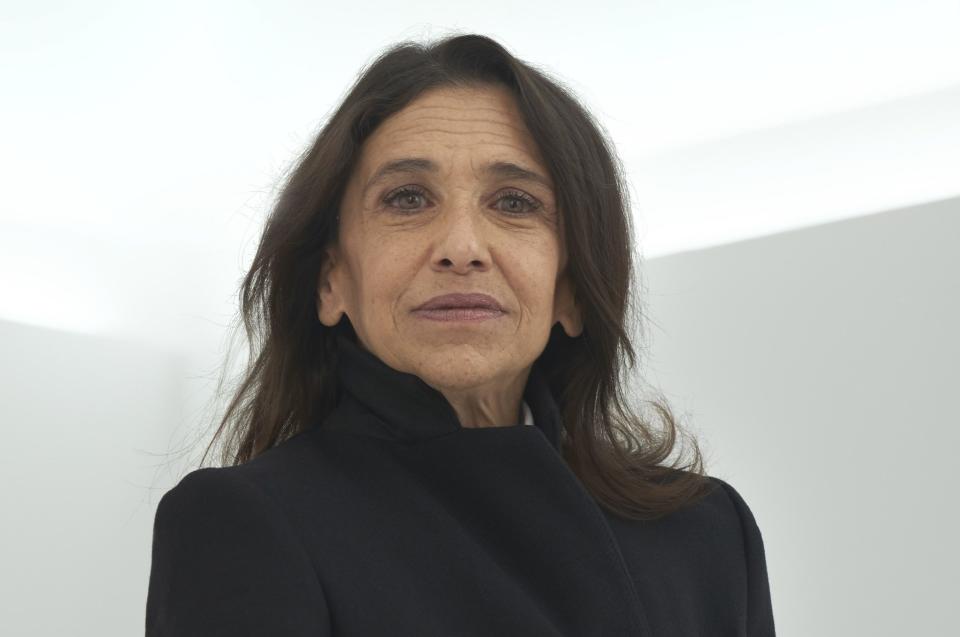The Singular Kathryn Hunter Goes from Crone to Crow in ‘The Tragedy of Macbeth’

She’s played Cleopatra, Lady M, King Lear — and his fool, too. She’s done Puck with Julie Taymor and Beckett with Peter Brook. She’s directed “Othello” for the Royal Shakespeare Company, adapted Kafka for the stage, and won an Olivier Award for Durrenmatt’s “The Visit.” But one thing Kathryn Hunter had never done is play all three of Macbeth’s witches, let alone seen it attempted in her decades in classical theater. The British-American actress, director, and physical theater innovator is outstanding in the unique role in “The Tragedy of Macbeth,” Joel Coen’s stripped-down, black-and-white take on the Shakespearean tragedy.
In just a few scenes, Hunter contorts her expressive body in unreal ways, snarls her voice into myriad tones and registers, and works the text like a true master. It’s a stunning performance that easily pulls all the focus, (yes, even from Denzel Washington and Frances McDormand), the kind of rarely seen onscreen performance that undoubtedly deserves awards.
More from IndieWire
A Child's First Divorced Christmas Is Sweetly Poignant in 'Like the Ones I Used to Know'
In 'The Worst Person in the World,' Star Renate Reinsve Gives the Best Performance of the Year
Hunter’s performance feels rare not only because of the way she looks, sounds, and moves, but also the tremendous amount of collaboration went into the process. For a director as prolific as Coen, for whom it would be easy to fall back on a signature style, it’s refreshing to see how working with Hunter inspired him. While Coen’s direction is almost sure to be recognized by Academy voters (he’s a shoe-in for a best director nomination most years he has a movie out), Hunter deserves some glory, too.
“It was a very wonderful way to work with a director, rather than just be given a costume and turn up on the day and say your lines,” she said. “That was the exciting thing working with Joel. It was completely new territory for him. Completely incognito. And he was excited and discovering at the same time.”
As a longtime fan of Coen’s films, Hunter was naturally thrilled when she got an email asking her to play the witches. Her enthusiasm was quickly tempered by the unusual change to the play.
“I was over the moon,” Hunter said. “I immediately said yes, and then sort of said, ‘All three?’ And Joel said, ‘Yes.’ ‘And how are we going to do that?’ So he said, ‘Well, we’ll figure it out.'”
They began rehearsing and trying on different interpretations, much as one would for a theatrical production. They nixed the idea of doubles, settling on playing the character as one witch with shapeshifting identities, as if she was possessed. Traditionally, there are three witches in “Macbeth,” and occasionally the film does show three figures, though they’re all Hunter.
“Sometimes we see three, because the three is such a magic number,” the actress said. “We agreed we didn’t want to do witchy, witchy, pointy nosy, nasal voices kind of witches. But Joel, because he has such an extraordinary imagination, very quickly gave a starting point, which was completely different. He said, ‘I think they’re crows. They’re like crows. And sometimes they’re like standing stones. And sometimes they’re women.’ So, his imagination immediately led me down a path that was very rich to explore.”

Courtesy of the artist
Though Hunter had played Lady M before, it was in a rushed three-week production. In an unusual reversal, working on the film actually afforded more time to dig into the text than she had experienced before.
“Frances [McDormand] and Joel felt very passionately that they wanted both time to explore the language and for the company to come together,” she said. “As actors, we’re all quite different, from different backgrounds. But somehow it feels like a cohesive world that Joel has created. Of course, helped by the black and white idiom of the film.”
At a brisk 105 minutes, Coen clearly made some changes to Shakespeare’s five-act structure, though “Macbeth” is the Bard’s shortest tragedy. The most significant change to affect Hunter’s part was doing the famous opening lines — “When shall we three meet again?” — as voiceover.
“I had a fraction of a second of thinking, ‘Oh, that’s one scene less for me.’ But I immediately realized that it was much more powerful in filmic terms to hear them,” Hunter said. “There’s more economy required in a film. And Joel’s done that all the way through. He’s stripped back. Rather than throw lots of visual cues, he’s stripped it back and it’s quite stark. It’s about atmospheres and shapes and lighting, so that we go deeply into Macbeth and his soul and his inner journey.”
Shakespeare wrote the play during the reign of James I, who had an obsession with witches. So he included, according to Hunter, “lots of cauldron stuff and witches brewing, because it was very popular at the time.”
“Joel’s kind of toned that down,” she said. “Particularly the so-called cauldron scene. He has the witches up in the rafters, rather than going round a cauldron, which I think is wonderful. We’ve seen enough cauldrons.”
Birds feature heavily in the visuals of the film, including foreboding black V formations piercing across gray skies. Coen noticed many references to birds in the text, Hunter said.
“Crows do have a reputation for being harbingers of death. But they’re also quite mysterious creatures,” said Hunter. “I did a lot of crow research of course, and they’re one of the most intelligent birds as well. And so, that sense that they have knowledge, they can look into the seeds of time. It seemed to cohere with the text.
In the cauldron scene, Hunter appears as three figures up in the rafters above Macbeth’s head, looking down at the camera. It’s a striking framing device that plays into the character’s crow-like similarities, and part of what makes Hunter’s performance unforgettable.
“I didn’t play a crow, but it was as if it was a woman who’d lived on a battlefield and seen lots of death and seen crows scavenging and somehow absorbed the body of a crow,” she said. “Like how children who are brought up by wolves start to run like wolves as well.”
Best of IndieWire
2021 Emmys Winners List: 'Ted Lasso,' 'The Crown,' and 'The Queen's Gambit' Lead the Night
2021 Emmy Predictions: Who Will Win at the Primetime Emmy Awards?
Sign up for Indiewire's Newsletter. For the latest news, follow us on Facebook, Twitter, and Instagram.


